Consequences of Vatican II
 |
 |
 |
 |
 |
 |
 |
What Is Behind Francis’
Rehabilitation of Judas?
On three different occasions, Francis has praised Judas publicly, suggesting that the apostle who betrayed Our Lord Jesus Christ is a misunderstood personality and "the end of his story" possibly is not Hell. We should not be surprised since on other occasions the same Pope, assuring us he is following in the tradition of John Paul II, proposes that Hell as a physical place does not exist as well.
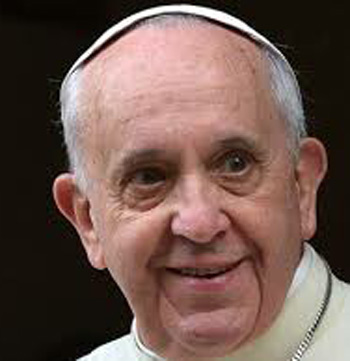 The most recent attempt to rehabilitate Judas is in the book Padre Nostro, an interview Francis granted to Don Marco Posso.
An excerpt published by Il Corriere della Sera on November 23, 2017, reveals Francis’ denial of the traditional Catholic teaching that Judas was condemned. Of the three persons involved in Christ's Passion – St. Peter, the good thief and Judas – Pope Bergoglio affirms that "the case that moves me most is Judas' shame."
The most recent attempt to rehabilitate Judas is in the book Padre Nostro, an interview Francis granted to Don Marco Posso.
An excerpt published by Il Corriere della Sera on November 23, 2017, reveals Francis’ denial of the traditional Catholic teaching that Judas was condemned. Of the three persons involved in Christ's Passion – St. Peter, the good thief and Judas – Pope Bergoglio affirms that "the case that moves me most is Judas' shame."
He goes through the story, presenting Judas as "a difficult character to understand": first, he sincerely repents; second, the "righteous ones" – the priests – reject him; third, since he "can't find a way out of his situation," he is overcome with a "guilt that suffocates him." A sympathetic portrayal of the traitor Judas, who, according to the Pope, is himself betrayed by the lack of mercy of the "righteous ones," the priests...
Then, he goes on to find a conjectural medieval "proof" for his theory that Judas could be saved: "Perhaps someone might think, ‘this pope is a heretic…’ But, no! They should go see a particular medieval capital of a column in the Basilica of St. Mary Magdalen in Vézelay, Burgundy [France] ... On that capital, on one side there is Judas, hanged; but on the other is the Good Shepherd, who is carrying him on his shoulders and is carrying him away.”
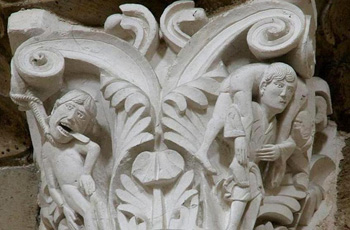 Francis confesses that he loves that particular sculpture and his falsified interpretation so much that he has a photograph of it behind his desk at the Vatican to help him meditate on the great mercy of God. “There is a smile on the lips of the Good Shepherd, which I wouldn’t say is ironic, but a little bit complicit,” he explains.
Francis confesses that he loves that particular sculpture and his falsified interpretation so much that he has a photograph of it behind his desk at the Vatican to help him meditate on the great mercy of God. “There is a smile on the lips of the Good Shepherd, which I wouldn’t say is ironic, but a little bit complicit,” he explains.
For anyone with a middling knowledge of medieval art and theology, this interpretation is a blatant misrepresentation of History. First the column in the Vézelay Basilica that houses the relics of St. Mary Magdalene is obviously presenting Judas as the traitor and a symbol of horror and offering it for public disdain: His tongue hangs grotesquely out of his mouth and his eyes pop out madly as he hangs from the noose he fashioned for himself in despair.
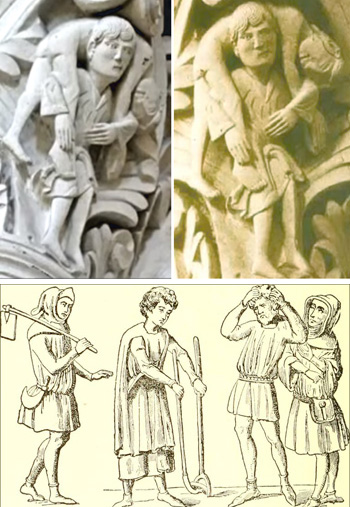 This capital was carved between 1115 and 1120, Art History books tell us, and was intended, like similar depictions in other churches, to graphically bring to the minds of the faithful the terrible fate of the apostle who betrayed Christ, which was believed and preached to be the eternal fires of Hell. This is, in fact, where Dante – following traditional Catholic teaching – places Judas, in the deepest pit, or ninth circle, reserved for the greatest traitors.
This capital was carved between 1115 and 1120, Art History books tell us, and was intended, like similar depictions in other churches, to graphically bring to the minds of the faithful the terrible fate of the apostle who betrayed Christ, which was believed and preached to be the eternal fires of Hell. This is, in fact, where Dante – following traditional Catholic teaching – places Judas, in the deepest pit, or ninth circle, reserved for the greatest traitors.
The man carrying off the dead body could hardly be the "Good Shepherd," or Jesus Christ, as Pope Bergoglio pretends. By the 11th century Christ was always portrayed in art and sculpture with a divine halo, a beard and invariably dressed in a long robe, the seamless garment Our Lady wove for Him.
This clean-shaven man with his short laborer tunic and without a halo is clearly carrying out the distasteful job of carting off the body of the suicidal Judas who, according to custom, received a shameful burial after dusk. Thus, the worker's "ironic" expression that Francis prefers to interpret as Christ's "complicity" with the crime of Judas has nothing to do with feelings of empathy; instead it simply expresses the repugnance of that worker in carrying such a disgusting burden.
Francis, so eager to rehabilitate Judas and imagine he could be saved, blatantly falsifies not only the symbolism of the column of Vézelay, but also medieval theology.
Other instances of Francis saving Judas
This is not the first time Francis has tried to save Judas. He brought up this same column in Vézelay Basilica in an interview with the German magazine Zeit of March 8, 2017, using it again as a supposed teaching lesson of medieval theology about the mercy of Christ and possible salvation of Judas.
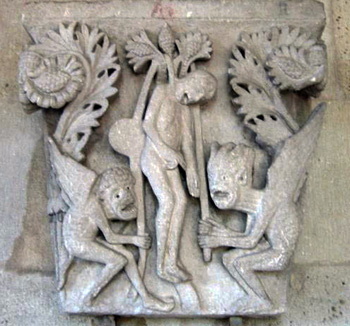 "I do not claim that Judas is in heaven and saved. But I do not claim the opposite," Francis stated. "I can only say, look at this capital and what the monks of the Middle Ages thought, who taught the catechism with their sculptures. And look at the Bible in which it is said: When Judas becomes conscious of his deed, he goes to the high priests. The Bible uses the word repentance. Perhaps he has not pledged forgiveness, but he has repented.”
"I do not claim that Judas is in heaven and saved. But I do not claim the opposite," Francis stated. "I can only say, look at this capital and what the monks of the Middle Ages thought, who taught the catechism with their sculptures. And look at the Bible in which it is said: When Judas becomes conscious of his deed, he goes to the high priests. The Bible uses the word repentance. Perhaps he has not pledged forgiveness, but he has repented.”
Nothing could be further from Catholic teaching. Since the time of early Church Fathers, the Church judged suicide to be a mortal sin as an act of injustice toward God the Creator and a severe offense against the charity man owes himself. Thus, she condemned this act of despair as a most atrocious crime and denied the person who committed suicide a Christian burial. To this mortal sin Judas added the crime of betraying the Man-God. This was the constant teaching of the monks of the Middle Ages, not the nonsense of Francis.
Finally, in a homily of June 12, 2016 on God's tenderness, Pope Bergoglio describes Judas sympathetically as a "lost sheep" who had repented. “I believe that the Lord will take that word [repentance] and bring it with Him,” he said. This repentance tells us that right until the end "God’s love was working in the soul of Judas."
Just following the teaching of von Balthasar
Why is Francis trying to rehabilitate Judas? Some blogs are asking this question, pretending that Francis is the first pontiff to support such bad doctrine.
In fact, he is only putting words to a teaching of Swiss theologian and priest Hans Urs von Balthasar, a mentor of both John Paul II and Benedict XVI. Both pontiffs wholeheartedly supported von Balthasar's teaching, having only the highest praise for the theologian called the "most important of the 20th century." Card. Ratzinger admired his teachings so much he established the Casa Balthasar in Rome to spread his teachings, especially to seminarians.
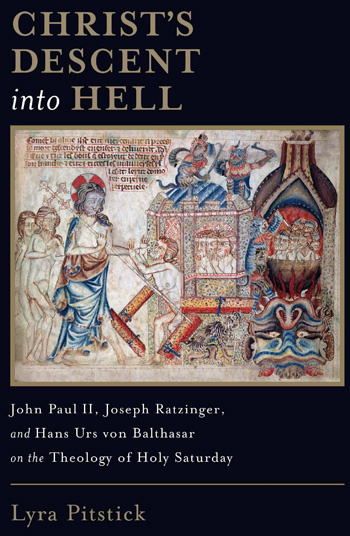 As Atila Guimarães aptly demonstrates in his book Animus Injuriandi I (Desire to Offend), von Balthasar was an early defender of Judas' treason. Unlike Francis, who parrots von Balthasar's thinking in his normal incoherent and ludicrous way, the Swiss theologian carefully constructed a whole new theology to save Judas from eternal condemnation.
As Atila Guimarães aptly demonstrates in his book Animus Injuriandi I (Desire to Offend), von Balthasar was an early defender of Judas' treason. Unlike Francis, who parrots von Balthasar's thinking in his normal incoherent and ludicrous way, the Swiss theologian carefully constructed a whole new theology to save Judas from eternal condemnation.
Following the theologian's reasoning, it was God the Father who betrayed Christ by delivering Him over to a cruel death. Thus, the Father did first what Judas did later. As Guimarães points out, the reader finds himself pressed to agree with von Balthasar that either both are traitors – God the Father and Judas – or neither is guilty.
Guimarães continues: "According to von Balthasar, then, Judas was chosen by God to play the role of His representative." With this, the theologian absolves Judas, presenting him as a minister of God, who executed the sentence of the Father (Animus Injuriandi I, pp. 48-50).
In another work von Balthasar endorses the theory of French poet Charles Peguy, according to which he imagines that Christ's love for Judas as He hung on the Cross was so great that He cried out like "a madman" to express His lack of conformity with the traitor's damnation. It is bad enough to present Our Lord as a mad man, but to suppose Christ's last words to the Father in His agony were inspired by pity for Judas is blasphemous. Von Balthasar goes on to paint an image of Judas that calls for our sympathy with the aim of lessening the just horror we should have for his treason (ibid., pp 51-53).
 This is the novel teaching of von Balthasar praised and supported by John Paul II and Benedict XVI. Francis now is just repeating the same story.
This is the novel teaching of von Balthasar praised and supported by John Paul II and Benedict XVI. Francis now is just repeating the same story.
To close, let me note that von Balthasar actually goes further than mere sympathy for Judas. Animus Injuriandi I shows that he proposes a "Church of the Condemned." He calls it "the Church most preferred by Our Lord. Christ is united with both the bad thief and Judas – the damned and most abandoned ones, like Christ himself – and descends with them into Hell. Then, He redeemed all the damned in Hell and ascends with them into Heaven, leaving Hell empty (Ibid., pp. 161-162, 165-166).
But there is more. Von Balthasar believes that, through the betrayal and suicide of Judas Iscariot, he played a role of co-redemption. Instead of shedding his blood for man like Christ, he empties his entrails, he poetically waxes... (Cf. ibid, p. 173).
As Guimarães’ study points out, "If someone who wanted to destroy the Catholic Faith and Church was searching for a theological explanation for this purpose, he hardly could find a more convenient thesis than this one expounded by von Balthasar" (Ibid., p. 176).
We see that Francis' muddled attempts to rehabilitate Judas are based on a much deeper and more offensive theology than what he could come up with on his own. It is the progressivist theology that inspired Vatican II and the Conciliar Church.
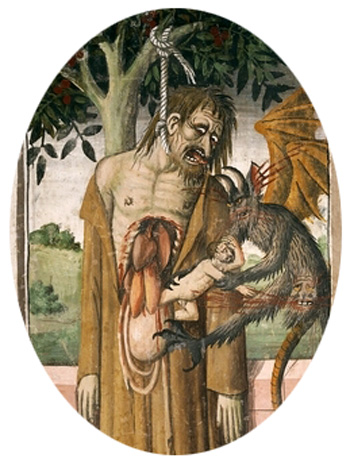


A defense of Judas being saved by Christ's mercy
He goes through the story, presenting Judas as "a difficult character to understand": first, he sincerely repents; second, the "righteous ones" – the priests – reject him; third, since he "can't find a way out of his situation," he is overcome with a "guilt that suffocates him." A sympathetic portrayal of the traitor Judas, who, according to the Pope, is himself betrayed by the lack of mercy of the "righteous ones," the priests...
Then, he goes on to find a conjectural medieval "proof" for his theory that Judas could be saved: "Perhaps someone might think, ‘this pope is a heretic…’ But, no! They should go see a particular medieval capital of a column in the Basilica of St. Mary Magdalen in Vézelay, Burgundy [France] ... On that capital, on one side there is Judas, hanged; but on the other is the Good Shepherd, who is carrying him on his shoulders and is carrying him away.”

The Judas column that Francis admires and displays behind his office desk
For anyone with a middling knowledge of medieval art and theology, this interpretation is a blatant misrepresentation of History. First the column in the Vézelay Basilica that houses the relics of St. Mary Magdalene is obviously presenting Judas as the traitor and a symbol of horror and offering it for public disdain: His tongue hangs grotesquely out of his mouth and his eyes pop out madly as he hangs from the noose he fashioned for himself in despair.

Medieval peasant clothing - the man on the column is clearly meant to be a worker, not Jesus
The man carrying off the dead body could hardly be the "Good Shepherd," or Jesus Christ, as Pope Bergoglio pretends. By the 11th century Christ was always portrayed in art and sculpture with a divine halo, a beard and invariably dressed in a long robe, the seamless garment Our Lady wove for Him.
This clean-shaven man with his short laborer tunic and without a halo is clearly carrying out the distasteful job of carting off the body of the suicidal Judas who, according to custom, received a shameful burial after dusk. Thus, the worker's "ironic" expression that Francis prefers to interpret as Christ's "complicity" with the crime of Judas has nothing to do with feelings of empathy; instead it simply expresses the repugnance of that worker in carrying such a disgusting burden.
Francis, so eager to rehabilitate Judas and imagine he could be saved, blatantly falsifies not only the symbolism of the column of Vézelay, but also medieval theology.
Other instances of Francis saving Judas
This is not the first time Francis has tried to save Judas. He brought up this same column in Vézelay Basilica in an interview with the German magazine Zeit of March 8, 2017, using it again as a supposed teaching lesson of medieval theology about the mercy of Christ and possible salvation of Judas.

Another medieval presentation of Judas’ suicide with devils taking his soul - Autun, France - 12th c.
Nothing could be further from Catholic teaching. Since the time of early Church Fathers, the Church judged suicide to be a mortal sin as an act of injustice toward God the Creator and a severe offense against the charity man owes himself. Thus, she condemned this act of despair as a most atrocious crime and denied the person who committed suicide a Christian burial. To this mortal sin Judas added the crime of betraying the Man-God. This was the constant teaching of the monks of the Middle Ages, not the nonsense of Francis.
Finally, in a homily of June 12, 2016 on God's tenderness, Pope Bergoglio describes Judas sympathetically as a "lost sheep" who had repented. “I believe that the Lord will take that word [repentance] and bring it with Him,” he said. This repentance tells us that right until the end "God’s love was working in the soul of Judas."
Just following the teaching of von Balthasar
Why is Francis trying to rehabilitate Judas? Some blogs are asking this question, pretending that Francis is the first pontiff to support such bad doctrine.
In fact, he is only putting words to a teaching of Swiss theologian and priest Hans Urs von Balthasar, a mentor of both John Paul II and Benedict XVI. Both pontiffs wholeheartedly supported von Balthasar's teaching, having only the highest praise for the theologian called the "most important of the 20th century." Card. Ratzinger admired his teachings so much he established the Casa Balthasar in Rome to spread his teachings, especially to seminarians.

JPII and Benedict XVI considered von Balthasar a master & followed his teachings on Hell
Following the theologian's reasoning, it was God the Father who betrayed Christ by delivering Him over to a cruel death. Thus, the Father did first what Judas did later. As Guimarães points out, the reader finds himself pressed to agree with von Balthasar that either both are traitors – God the Father and Judas – or neither is guilty.
Guimarães continues: "According to von Balthasar, then, Judas was chosen by God to play the role of His representative." With this, the theologian absolves Judas, presenting him as a minister of God, who executed the sentence of the Father (Animus Injuriandi I, pp. 48-50).
In another work von Balthasar endorses the theory of French poet Charles Peguy, according to which he imagines that Christ's love for Judas as He hung on the Cross was so great that He cried out like "a madman" to express His lack of conformity with the traitor's damnation. It is bad enough to present Our Lord as a mad man, but to suppose Christ's last words to the Father in His agony were inspired by pity for Judas is blasphemous. Von Balthasar goes on to paint an image of Judas that calls for our sympathy with the aim of lessening the just horror we should have for his treason (ibid., pp 51-53).

JPII embraces his mentor von Balthasar
To close, let me note that von Balthasar actually goes further than mere sympathy for Judas. Animus Injuriandi I shows that he proposes a "Church of the Condemned." He calls it "the Church most preferred by Our Lord. Christ is united with both the bad thief and Judas – the damned and most abandoned ones, like Christ himself – and descends with them into Hell. Then, He redeemed all the damned in Hell and ascends with them into Heaven, leaving Hell empty (Ibid., pp. 161-162, 165-166).
But there is more. Von Balthasar believes that, through the betrayal and suicide of Judas Iscariot, he played a role of co-redemption. Instead of shedding his blood for man like Christ, he empties his entrails, he poetically waxes... (Cf. ibid, p. 173).
As Guimarães’ study points out, "If someone who wanted to destroy the Catholic Faith and Church was searching for a theological explanation for this purpose, he hardly could find a more convenient thesis than this one expounded by von Balthasar" (Ibid., p. 176).
We see that Francis' muddled attempts to rehabilitate Judas are based on a much deeper and more offensive theology than what he could come up with on his own. It is the progressivist theology that inspired Vatican II and the Conciliar Church.

A 15th century depiction of Judas’ suicide

Posted December 6, 2016
______________________
______________________
 Volume I |
 Volume II |
 Volume III |
 Volume IV |
 Volume V |
 Volume VI |
 Volume VII |
 Volume VIII |
 Volume IX |
 Volume X |
 Volume XI |
 Special Edition |


